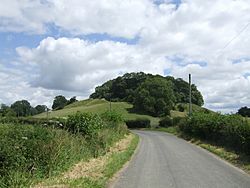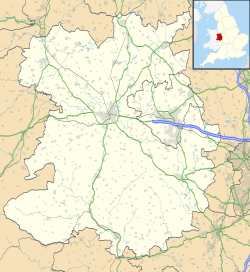Caus Castle facts for kids
Quick facts for kids Caus Castle |
|
|---|---|
| Westbury, Shropshire in England | |
 |
|
| Coordinates | 52°39′45″N 2°58′36″W / 52.662539°N 2.976543°W |
| Grid reference | SJ340076 |
| Type | Hill fort and medieval castle |
Caus Castle is the ruined remains of an old hill fort and a medieval castle. You can find it near Westbury in Shropshire, England.
The castle sits high up on the eastern hills of the Long Mountain. It used to guard an important route. This route went from Shrewsbury to Montgomery, Powys, right on the border between England and Wales. Caus Castle was destroyed during the English Civil War and has been a ruin ever since.
Contents
The Story of Caus Castle
How Caus Castle Began
The very first parts of Caus Castle were likely built a long, long time ago. These early earthworks, or big ditches and mounds, were probably an Iron Age hillfort. Later, the Normans built a motte-and-bailey castle here. This type of castle had a tall mound (the motte) with a tower on top, and a walled courtyard (the bailey).
The Corbet Family and the Castle
After the Normans took over England, a knight named Roger le Corbet was given many lands in Shropshire. This happened in 1069, thanks to William the Conqueror. These lands became known as the Barony of Caus. The name came from Roger's family estate in France.
The Corbets had to be loyal to Roger de Montgomery, who was the first Earl of Shrewsbury. Their job was to help control the Welsh Marches, which was the border area with Wales. Roger le Corbet built Caus Castle in the late 11th century. It had a very tall motte with a small tower on top. It also had a strong inner bailey, which was a well-protected courtyard.
Royal Interest and New Buildings
Caus Castle was so important that the King of England cared about it. In 1165, Henry II of England sent soldiers to guard it. Later, in 1198, Roger Corbet rebuilt parts of the castle using stone. He improved the tower, the main keep, and the outer walls.
Around the late 12th century, a small town or "borough" grew up in the large outer bailey of the castle. In 1263, the King even gave money to help build more parts of the castle. This is when D-shaped towers were added to the outer walls. The town had two churches, St Margaret's and St Nicholas'. We know of two streets, Castle Street and St Margaret Street.
Life in the Castle Town
When Beatrice Corbet died in 1347, Caus Castle passed to the Earl of Stafford. At its busiest, the town had 58 residents in 1349. This was the same year the terrible Black Death arrived in England.
Challenges and Changes
In the 15th century, during the rebellion of Owain Glyndŵr, Caus Castle was guarded by Griffith ap Ieuan. But he later switched sides to support Glyndŵr. Because of this, his family lost their lands and their role at Caus Castle in 1404. However, they got them back in 1419. This happened after his sons helped capture a famous rebel named John Oldcastle.
A sad event happened at Caus Castle in 1443. A knight named Sir Gruffudd Vychan accidentally killed his master, Sir Christopher Talbot, during a jousting practice. Sir Christopher was known as the best jouster in England. Sir Gruffudd was declared an outlaw, and a reward was offered for his capture. His lands were given to another lord.
The Castle's Decline
The Earl of Stafford rarely used Caus Castle in the 15th and 16th centuries. Because of this, the castle started to fall apart. By 1521, it was described as being in "great decay." In 1541, only two people lived there.
The castle was later given as part of a marriage agreement to John Thynne. But another noble, Edward Stafford, 3rd Baron Stafford, argued about who owned it. John Thynne and his wife Joan took Caus Castle by force in 1591. Joan lived at Caus while John was at another estate. Their letters show that Joan was very involved in managing their lands.
The End of Caus Castle
Caus Castle was finally left empty after it was destroyed during the English Civil War. It was a small Royalist base and fell in June 1645. Since then, it has remained a ruin.
Images for kids



